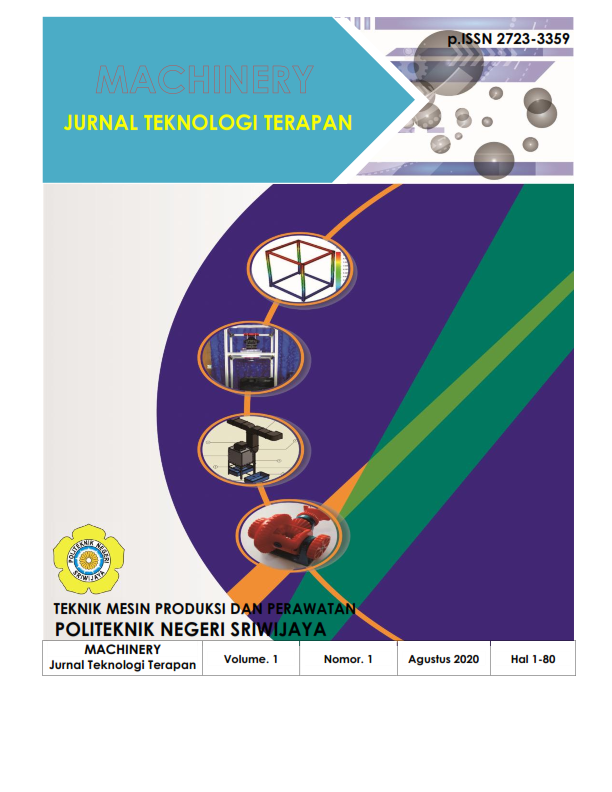PENGARUH QUENCHING TERHADAP KEKERASAN MATERIAL BAJA JIS SUP 9
DOI:
https://doi.org/10.5281/zenodo.4540929Keywords:
Production and MaintenanceAbstract
JIS SUP 9 Steel is a medium carbon steel with chemical content of 0,544% C, 0,238% Si, 0,820% Mn, 0,0146% P, 0,0030% S, 0,754% Cr, 0,0102% Mo, 0,00665% Ni, 0,0390% Al, 0,0095% Co, 0,0156% Cu, 0,0142% Ti, 0,0011% Sn, 0,0022% As, 0,0039% Zr, 0,0039% Zr, 0,0036% Ce, 0.0022% Se, 0,0047% Te, 0,0402% Ta, 0.00021% B, 0,0012% Zn, 0,00053% La, 97,4% Fe. The carbon content allows the steel to be hardened by a heat treatment process, hardening and cooling media. The temperature variations used were 750 ℃, 800℃,900℃ with a holding time of 30 minutes and cooled using salt water, oil and vegetable oil. This study aims to determine the effect of hardening and quenching processes on the hardness of JIS SUP 9 steel. The test results data were analyzed using ANOVA with full factorial level design, main effect model design, and 3 replications assisted by Design-Expert software. From the hardness test, the maximum hardness value of 59.2 HRC was obtained from the hardening process with oil cooling media at a temperature of 800 ℃, while the minimum hardness value obtained from the brine cooling medium was 16.5 HRC at a temperature of 750 ℃. The results of the analysis revealed that the main factor that had the most influence on increasing the hardness of the test specimens was the brine quenching media factor with a contribution percentage of 98.93%. Meanwhile, the increasing factor of hardness in oil quenching media with a contribution percentage of 98.02% and quenching vegetable oil with a percentage contribution of 98.80%.
Â
Keywords: JIS SUP 9 Steel, Hardening, Quenching, ANOVA, Full FactorialDownloads
References
Doloksaribu. M, Afrilinda. E. 2014. Peningkatan kualitas dodos dengan variasi temperatur austenisasi dan media quenching.
Halimi, Ahmad Dzulfikri. 2017. Uji Eksperimen Tingkat Kekerasan Dan Ketangguhan Baja Pegas Jis Sup 9 Dengan Metode Laku Panas Hardening dan Tempering. JTM Volume 05 Nomor 03.
Heling. E, Prayitno. D. 2019. Pengaruh karburisasi yang dilanjutkan dengan proses quenching dalam media air terhadap kekerasan baja s45c. Universitas Trisakti Vol. 4, No. 2.
Mersilia, Anggun dkk. 2016. Pengaruh Heat Treatment Dengan Variasi Media Quenching Air Garam dan Oli Terhadap Struktur Mikro dan Nilai Kekerasan Baja Pegas Daun AISI 6135.
Murtiono, Arif. 2012. Pengaruh quenching dan tempering terhadap kekerasan dan kekuatan tarik serta struktur mikro baja karbon sedang untuk mata pisau pemanen sawi. Jurnal e-Dinamis, Volume II, No.2.
Umartono, agus.s Dan Awali, Subhan. 2015. Analisa kegagalan proses heat treatment baja sup-9 pada pembuatan pegas daun. Teknik Mesin, Fakulitas Teknik, Universitas Gresik. Jurnal Volume 04, Nomor 01, juni 2015.
Downloads
Published
How to Cite
Issue
Section
License
The Authors submitting a manuscript do so on the understanding that if accepted for publication, copyright of the article shall be assigned to MACHINERY: Jurnal Teknologi Terapan as publisher of the journal. Copyright encompasses rights to reproduce and deliver the article in all form and media, including reprints, photographs, microfilms, and any other similar reproductions, as well as translations.Â
MACHINERY: Jurnal Teknologi Terapan and the Editors make every effort to ensure that no wrong or misleading data, opinions or statements be published in the journal. In any way, the contents of the articles and advertisements published in MACHINERY: Jurnal Teknologi Terapan are the sole responsibility of their respective authors and advertisers.








